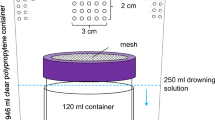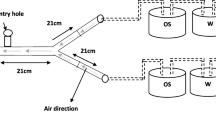Abstract
Of various chopped vegetables tested,Allium spp. high in propyl-containing alkyl sulfides (e.g.,cepa group) caught the most onion flies in trapping tests in the field. Fly catches to chopped onion increased with bait quantity. Attractancy of chopped onion changed dramatically during aging in the field; catch increased over the first few days, peaked at ca. fivefold over fresh material by 3–5 days, and then declined sharply. This age-dependent increase in attraction was not seen for garlic (known to have antimicrobial properties) nor with chopped onion mixed with chopped garlic. These data suggested that attraction of onion flies to onions was strongly influenced by microbial activity associated with decomposing onions. The bacteriumKlebsiella pneumoniae was identified as a major colonizer of onions maximally attractive to onion flies. This increased attraction is not due to the previously reported microbially produced volatiles ethyl acetate and tetramethyl pyrazine.
Similar content being viewed by others
References
Al-Delaimy, K.S., andAli, S.H. 1970. Antimicrobial action of vegetable extracts on the growth of pathogenic bacteria.J. Sci. Food Agric. 21:110–111.
Bernhard, R.A. 1970. Chemotaxonomy: Distribution studies of sulfur compounds inAllium.Phytochemistry 9:2019–2027.
Borror, D.J., andDeLong, 1964. An Introduction to the Study of Insects, 2nd ed. Holt, Rinehart and Winston, New York.
Buchanan, R.E. andGibbons, N.E. 1974. Bergey's Manual of Determinative Bacteriology, 8th ed. Williams and WilkinsBaltimore.
Dindonis, L.L., andMiller, J.R. 1980a. Host-finding responses of onion and seedcorn flies to healthy and decomposing onions and several synthetic constitutents of onion.Environ. Entomol. 9:467–472.
Dindonis, L.L., andMiller, J.R. 1980b. Host-finding behavior of the onion fly,Hylemya antiqua.Environ. Entomol. 9:769–772.
Dindonis, L.L., andMiller, J.R. 1981a. Onion fly trap catch as affected by release rates ofn- dipropyl disulfide from polyethylene enclosures.J. Chem. Ecol. 7:411–418.
Dindonis, L.L., andMiller, J.R. 1981b. Onion fly and little house fly host-finding selectively mediated by decomposing onion and microbial volatiles.J. Chem. Ecol. 7:419–426.
Eckenrode, C.J., Vea, E.V., andStone, K.W. 1975. Population trends of onion maggots correlated with air thermal unit accumulations.Environ. Entomol. 4:785–789.
Guyer, G.E., andWells, A. 1959. Evaluation of insecticides for control of the chlorinated hydrocarbon resistant onion maggot.Mich. Agric. Exp. Stn. Q. Bull. 41:614–623.
Harris, M.O. 1982. Role ofAllium visual and chemical stimuli in the oviposition behavior ofDelia antiqua (Meigen). MS thesis. Michigan State University.
Harris, C.R., Tholman, J.A., andSvec, H.J. 1982. Onion maggot resistance to some insecticides following selection with parathion or carbofuran.Can. Entomol. 114:681–685.
Holdeman, L.V., andMore, W.E.C. 1972. Anaerobe Laboratory Manual. Virginia Polytechnic Institute and State University, Blacksburg.
Hwang, Yih-Sheen., Mulla M.S., andAxelrod, H.A. 1978. Attractants of synanthropic flies—ethanol as attractant forFannia cannicularis and other pest flies in poultry ranches.J. Chem. Ecol. 4:463–470.
Ikeshoji, T., Ishikawa, Y., Matsumoto, Y. 1980. Attractants against the onion maggots and flies,Hylemya antiqua, in onions inoculated with bacteria. J. Pestic. Sci. 5:343–350.
Ishikawa, Y., Ikeshoji, T., andMatsumoto, Y. 1981. Field trapping of onion and seed-corn flies with baits of fresh and aged onion pulp.Appl. Entomol. Zool. 16:490–493.
Lennette, E.H., Spaulding, E.H., andTruant, J.P. 1974. Manual of Clinical Microbiology, 2nd ed. American Society for Microbiology, Washington, D.C.
Loosjes, M. 1976. Ecology and genetic control of the onion fly,Delia antiqua (Meigen). Agric. Res. Rep. (Versl. landbouwk. Onderz.) 857. Pudoc, Wageningen. 179 pp.
Matsumoto, Y. 1970. Volatile organic sulfur compounds as insect attractants with special reference to host selection, pp. 133–158,in D. Wood, R. Silverstein, and N. Nakajima (eds.). Control of Insect Behavior by Natural Products. Acadmic Press, New York.
Miller, J.R., andHaarer, B.K. 1981. Yeast and corn hydrolysates and other nutritious materials as attractants for onion and seed flies.J. Chem. Ecol. 7:555–562.
Saghir, A.R., Mann, L.K., Bernhard, R.A., andJacobsen, J.V. 1966. Determination of aliphatic mono- and disulfides inAllium by gas chromatography and their distribution in the common food species.Am. Soc. Hortic. Sci. 84:386–398.
Schneider, W.D., Miller, J.R., Breznak, J.A., andFobes, J.F. 1983. Onion maggot,Delia antiqua, survival and development on onions in the presence and absence of microorganisms.Entomol. Exp. Appl. 33:50–56.
Tomioka, T. 1977.Shokubutsu Boeki 31:206–209 (in Japanese).
Vernon, R.S., Judd, G.J.R., Borden, J.H., Pierce, H.O., Jr., andOehlschlager, A.C. 1981. Attraction ofHylemya antiqua (Meigen) (Diptera: Anthomyiidae) in the field to host-produced oviposition stimulants and their non-host analogues.Can. J. Zool. 59:872–881.
Author information
Authors and Affiliations
Additional information
Diptera: Anthomyiidae.
Paper No. 11047 of the Michigan State University Agricultural Experiment Station.
Rights and permissions
About this article
Cite this article
Miller, J.R., Harris, M.O. & Breznak, J.A. Search for potent attractants of onion flies. J Chem Ecol 10, 1477–1488 (1984). https://doi.org/10.1007/BF00990317
Received:
Revised:
Issue Date:
DOI: https://doi.org/10.1007/BF00990317




